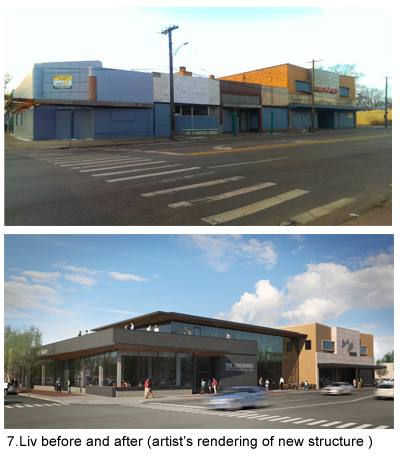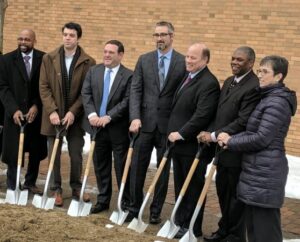Catalysts for a Comeback: PM Environmental and Detroit’s 7.Liv
Today was groundbreaking day for 7.Liv, Detroit’s newest neighborhood revitalization project. The backstory of this urban revival shows that PM Environmental is the right partner behind the scenes to make the most of opportunities below the surface.
The crowd gathered near the corner of Seven Mile Road and Livernois included a local entrepreneur and developer, representatives from the public and private investment community, and several Detroit dignitaries, including Mayor Mike Duggan.
They were there to celebrate the city’s latest comeback story in the making: a mixed-use development planned for the former B. Siegel department store on the once-renowned Avenue of Fashion. The ambitious project involves rehabilitating the dilapidated store and demolishing and replacing two adjoining structures with 10,000 square feet of new construction.
Once completed, the development, dubbed 7.Liv, will be home to retail businesses, a restaurant and ten units of much-needed apartment housing for staff and students of two nearby colleges, as well as new underground parking.
7.Liv is the vision of Detroit entrepreneur and developer Matthew Hessler, a longtime resident of the adjacent Sherwood Forest neighborhood, which is experiencing its own resurgence.
Hessler purchased the parcel in 2016. “As a handful of new retailers and restaurants have begun to open storefronts on the avenue, 7.Liv will replace the blighted structures on the corner of the two main thoroughfares with a vibrant new mixed-use development,” he explained. “7.Liv will serve as a catalyst, allowing businesses to fill in along the avenue and create momentum for a new walkable shopping district along the old Avenue of Fashion.”
Judging by the turnout at today’s event, Hessler isn’t the only stakeholder enthusiastic about bringing 7.Liv to life.
While most of the project’s estimated $8 million capital investment is privately funded, a significant portion will come from public grants and incentive-based financing, anchored by a Community Revitalization Program (CRP) grant from the Michigan Economic Development Corporation (MEDC). That grant is substantially higher than typically awarded, demonstrating the MEDC’s belief in 7.Liv’s potential to be the catalyst of the neighborhood’s comeback.
Navigating the Brownfield Challenge
 Before construction could begin on 7.Liv, a plan was needed to resolve issues dwelling (literally) beneath the surface. Prior to the advent of natural gas heating, structures on the property were heated by fuel oil stored in underground tanks. Contamination that was identified as associated with the former fuel oil tanks resulted in the property’s classification as a brownfield.
Before construction could begin on 7.Liv, a plan was needed to resolve issues dwelling (literally) beneath the surface. Prior to the advent of natural gas heating, structures on the property were heated by fuel oil stored in underground tanks. Contamination that was identified as associated with the former fuel oil tanks resulted in the property’s classification as a brownfield.
Brownfield environmental cleanup adds complexity to a construction project. It also opens a door for additional financial assistance.
Enter PM Environmental’s Brownfield Team. They performed the initial environmental assessment for the parcel’s previous broker-owner. Hessler sought their guidance in preparing a brownfield plan and seeking funding through the Brownfield Redevelopment Act, aka Act 381.
Act 381 under the Detroit Brownfield Redevelopment Authority allows for the use of tax increment financing (TIF). The city continues to collect tax revenue on the property, and once it is rehabilitated and generating additional tax revenue, the developer is reimbursed through these incremental tax revenues every year until the eligible activities are repaid.
“Navigating both the financing and the eventual cleanup requires special expertise,” said Jessica DeBone, Regional Manager of Economic Incentives at PM Environmental and the company’s project manager for 7.Liv. “We help our clients manage every detail, from writing the brownfield plan to attending meetings with city and state representatives. The real work begins long before the first shovel hits the ground.”
Unearthing Additional Opportunity
PM Environmental’s brownfield plan included the environmental steps needed to remove the orphan tanks along with contaminated soil and groundwater unearthed during construction, as well as outlining contingency plans in the unlikely event that vapor intrusion is detected.
In addition to detailing these expected targets for reimbursement, PM Environmental helped identify another surprising – and significant – opportunity. Act 381 funding could also offset part of the cost of developing the site’s new underground parking structure.
“TIF financing allows for reimbursement of various specific eligible activities,” explained DeBone. “We worked with the developer and the contractor to find the activities that qualified, including non-environmental tasks, and detailed everything in the brownfield plan.”
The result of the team’s efforts: $1,175,801 in Act 381 TIF reimbursement for 7.Liv.
A Catalyst for the Catalyst
PM Environmental’s know-how extended beyond the brownfield plan. DeBone’s team looked at each step in the project to determine whether it would qualify for TIF reimbursement or CRP grant funding, maximizing the benefits of both platforms for all parties involved.
They also played a hands-on role in helping everyone stay organized and on track. “We worked closely with both the brownfield and CRP teams,” said DeBone. “That meant monitoring the completion of the site plans, and comparing and coordinating timelines for the availability of incentive financing, closing dates for private financing, and groundbreaking. We tried to help everyone keep an eye on the big picture.”
Just as Liv.7 will be a catalyst for the future of its neighborhood, PM Environmental serves as a catalyst for moving complex incentive-funded development projects forward. “There’s so much more to projects like this than the cleanup plan,” said DeBone. “That’s what makes them so exciting and challenging for us.”

